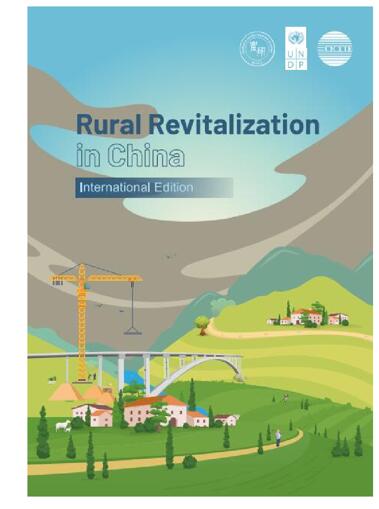 The report “Rural Revitalization in China”was jointly developed by the Research Center for Rural Economy of Ministry of Agriculture and Rural Affaires of China, the United Nations Development Program (UNDP) , and the China International Center for Economic and Technical Exchange(CICETE) and was released in March 2025.
The report “Rural Revitalization in China”was jointly developed by the Research Center for Rural Economy of Ministry of Agriculture and Rural Affaires of China, the United Nations Development Program (UNDP) , and the China International Center for Economic and Technical Exchange(CICETE) and was released in March 2025.
This report summarizes China’s actions and achievements in enhancing living standards as well as agricultural output in the countryside, through its rural revitalization strategy. It also highlights key policy documents supporting this, including the Strategic Plan for Rural Revitalization (2018-2022); its phased goals for rural revitalization; and the ‘five pillars’ guiding this.
By implementing its rural revitalization strategy and other relevant national strategies, including the poverty alleviation campaign, rural areas of China are catching up with the rapid pace of urban development. These positive developments and results provide valuable insights, best practices and lessons learned on pragmatic approaches to advance rural development across various provinces in China.
A notable approach in China’s rural revitalization strategy has been its emphasis on enhancing the role of technology in the agricultural sector to increase agricultural outputs and contribute to food security. According to the National Development and Reform Commission (NDRC) in 2022, more than 72 percent of ploughing, planting and harvesting was mechanized, up 6 percentage points from 2017. This has helped to lift China’s per capita grain output, reaching 483 kg in 2021, compared with 472 kg in 2018.
In tandem with agricultural development, the report also highlights how rural incomes have grown, consolidating decades of dedicated efforts in addressing poverty alleviation, with the government announcing its achievement in meeting its goal of eradicating extremely rural poverty by the end of 2020. Rural residential incomes continued to climb, with the urban-rural income gap falling to 2.5:1 in 2021.
The rural revitalization strategy has also focused on ensuring a more liveable environment in rural areas. Since 2018, more than 40 million rural household toilets around the country have been renovated, with more than 70 percent of rural households now having access to sanitary toilets. The system for collecting, transferring, treating and disposing of domestic waste now also covers more than 90 percent ofvillages.
China’s rural revitalization strategy also emphasizes the importance of protecting arable land, water-saving irrigation, as well as agricultural resource conservation and utilization. The average quality rating of China’s arable lands has improved from 5.11 in 2014, to 4.76 in 2019. By the end of 2019, 226,000 square kilometres of land in China was upgraded with water-saving irrigation. The use of chemical fertilizers and pesticides has also fallen prominently during the 13th Five-Year-Plan (2015-2020).
Despite these achievements, a key challenge identified is rural to urban migration, resulting in the steady outflow of talented and educated individuals who largely continue to move from the countryside to cities. To effectively retain and attract human capitals for rural development, a series of policies and measures to progressively expand its rural human resource pool have been undertaken, including providing targeted education and training opportunities, creating incentives for talented individuals to remain in or return to rural areas, as well as fostering rural entrepreneurship and innovation. Lessons learned have indicated that such efforts must continue to be expanded further in the future, to ensure their lasting effectiveness.
Overall, China’s experience in rural revitalization offers valuable insights and lessons for global learning on accelerating progress towards the 2030 Agenda for Sustainable Development and the 17 Sustainable Development Goals (SDGs),10 to end poverty everywhere and protect the planet.
The actions and achievements from China’s rural revitalization strategy also underscore the critical importance of all stakeholders playing their part in achieving the SDGs. This encompasses the need for a whole-of-government approach in forming and implementing policies; unlocking the positive role of the private sector to accelerate inclusive socio-economic growth; leveraging technical insights and development solutions from academia; as well as engaging local communities in co-designing and implementing solutions for an inclusive, sustainable and resilient future.
This reportcomprises seven interconnected sections. It begins with a Background section contextualizing the strategy's emergence amidst rural poverty and urban-rural disparities, followed by an overview of the Rural Revitalization Strategy which details its five pillars-industrial, human capital, cultural, ecological and organizational revitalization-along with key policies and national goas. Subsequent sections detail actionable dimensions: Revitalization of Rural Industry discuses policy frameworks, achievements in modern agriculture and rural industries, and remaining challenges; Human Capital Revitalization focuses on developing a skilled rural workforce through training, returning talent, and institutional support; Culture Revitalization highlights efforts to protect heritage, improve rural cultural services, and promote ethical values; Ecological Revitalization focuses on sustainable practices, pollution control, and rural environmental upgrades; and Organizational Revitalization details enhancing grassroots governance, strengthening village-level institutions, and modernizing rural administration. Collectively, the report demonstrates China’s integrated approach to rural development, offering insights for sustainable development globally.
Click here to access and download the full manual for more detailed information.
Related Links:

